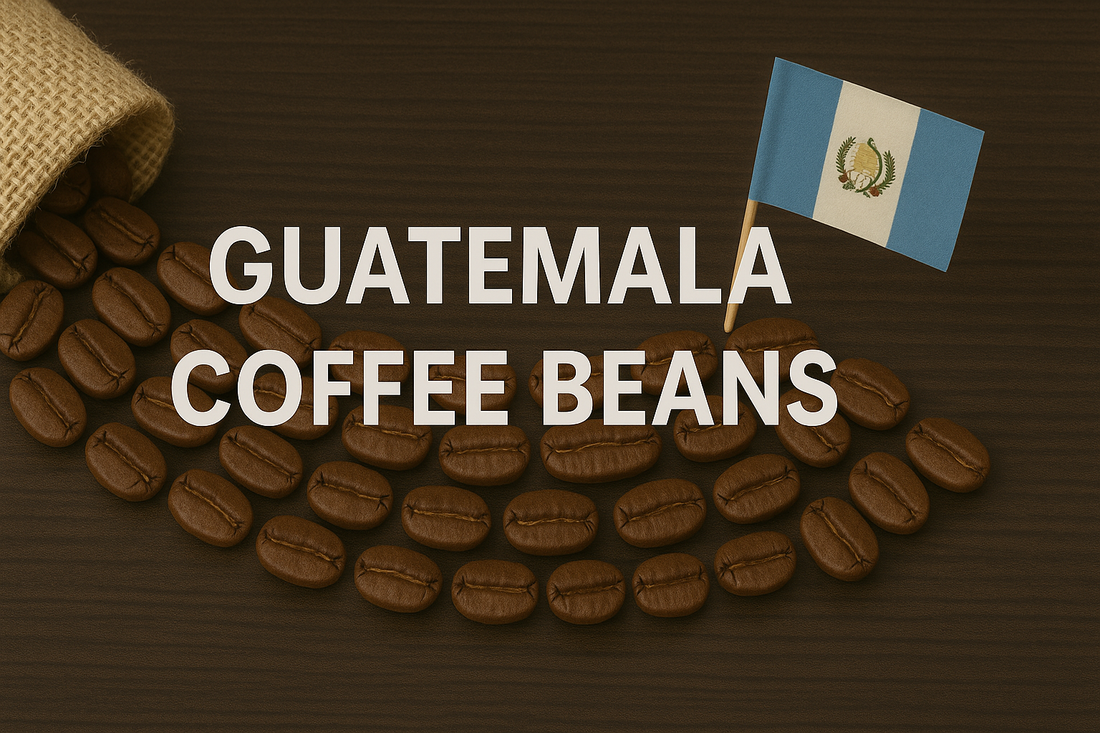
Guatemala Coffee Beans
正啟 GLOBALEYESShare this news
Coffee was first introduced to Guatemala by Jesuit priests in 1750, with significant industrial development later initiated by German settlers in the late 19th century. Today, most coffee production is concentrated in the southern part of the country, where the slopes of volcanic mountains such as the Volcán de Fuego provide ideal conditions for growing high-quality coffee beans. Coffees grown at these high altitudes thrive uniquely, producing a distinguished and complex blend of flavors, notably appreciated by coffee connoisseurs for their spicy notes. Among these, Guatemala’s Strictly Hard Beans (SHB) are particularly notable—full-bodied, flavorful, and well-balanced acidity. Guatemala's giant-sized beans, such as Maragogype, also garner special attention. Coffee production once brought prosperity to Guatemala and continues to dominate its national economy.

The volcanic soil enriched by ten volcanoes across Guatemala, coupled with altitudes nearing 2,000 meters, contributes to exceptional coffee quality, with approximately 45% of beans scoring above 80 points in cupping evaluations. Remarkably, Guatemala coffee delivers world-class quality at relatively accessible prices, offering excellent value.

As the world's sixth-largest coffee producer, Guatemala's economy relies heavily on coffee exports. The country hosts eight major coffee-growing regions featuring diverse terrains—including tropical rainforests, volcanic soils, and highland valleys—which generate over 300 distinct microclimates, resulting in an impressive diversity of coffee flavors.

Major Coffee Regions of Guatemala
Acatenango
Acatenango boasts Guatemala’s highest-altitude coffee farms. Neighboring active volcanoes (Fuego, Pacaya) and moist air currents from the Pacific create significant temperature variations between day and night, fostering an exceptional microclimate and coffees known for high sweetness.
- Altitude: 1,300–2,000 m
- Annual Rainfall: 1,200–1,800 mm
- Average Temperature: 14–31°C
- Humidity: 70–80%
- Harvest Season: December–March
- Soil Type: Volcanic pumice
Antigua
Antigua is often regarded as the birthplace of Guatemala’s coffee culture. Surrounded by three volcanoes (Agua, Fuego, Acatenango), Antigua offers mineral-rich volcanic soil and a stable, mild climate ideal for premium coffee cultivation.
- Altitude: 1,500–1,700 m
- Annual Rainfall: 800–1,200 mm
- Average Temperature: 18–22°C
- Humidity: 65%
- Harvest Season: January–Mid-March
- Soil Type: Volcanic pumice
Lake Atitlán
Lake Atitlán, Guatemala's largest volcanic lake, is encircled by volcanoes and is one of Guatemala’s five volcanic coffee regions. Coffee trees grow along slopes stretching toward the lake, thriving in rich organic soil, creating coffee beans with pronounced character due to its unique microclimate.
- Altitude: 1,500–1,700 m
- Annual Rainfall: 1,800–2,300 mm
- Average Temperature: 20–23°C
- Humidity: 75–85%
- Harvest Season: December–March
- Soil Type: Volcanic
Cobán Rainforest
Cobán, whose name means "place of clouds" in the local dialect, experiences the second-highest rainfall of all Guatemalan coffee regions. Coffee trees grow among natural rainforests on hillsides, benefiting from abundant moisture, producing coffee with pronounced fruity notes, lively acidity, and a rich, full-bodied profile.
- Altitude: 1,300–1,500 m
- Annual Rainfall: 3,000–4,000 mm
- Average Temperature: 15–20°C
- Humidity: 85–95%
- Harvest Season: December–March
- Soil Type: Limestone and clay

Fraijanes
Fraijanes is influenced by both volcanic activity and Atlantic weather systems. Its abundant sunlight, high elevation, and mineral-rich soil impart distinctly vibrant characteristics to the coffees produced here.
- Altitude: 1,400–1,800 m
- Annual Rainfall: 1,500–3,000 mm
- Average Temperature: 12–26°C
- Humidity: 70–90%
- Harvest Season: December–February
- Soil Type: Volcanic pumice

Huehuetenango Highlands
Huehuetenango, Guatemala’s highest non-volcanic region, has a dry climate characterized by steep valleys. Warm, dry winds from Mexico's Tehuantepec plain protect the region from frost damage.
- Altitude: 1,500–2,000 m
- Annual Rainfall: 1,200–1,400 mm
- Average Temperature: 20–24°C
- Humidity: 70–80%
- Harvest Season: January–April
- Soil Type: Limestone

New Oriente
The New Oriente region, characterized by frequent cloud cover and abundant rainfall, features soils enriched by past volcanic activity but with distinctive mineral profiles. Recognizing its exceptional coffee quality, the Guatemala Coffee Association officially included it among the eight major specialty coffee regions in 1980.
- Altitude: 1,300–1,700 m
- Annual Rainfall: 1,800–2,000 mm
- Average Temperature: 18–25°C
- Humidity: 70–80%
- Harvest Season: December–March
- Soil Type: Metamorphic rock and clay

Volcanic San Marcos
San Marcos is Guatemala’s rainiest and warmest coffee region, benefiting from extremely fertile volcanic soils. With the rainy season starting earlier than in other regions, coffee trees bloom sooner here. Frequent rains necessitate partial sun-drying, followed by machine drying.
- Altitude: 1,300–1,800 m
- Annual Rainfall: 4,000–5,000 mm
- Average Temperature: 21–27°C
- Humidity: 70–80%
- Harvest Season: December–March
- Soil Type: Volcanic

Guatemalan Coffee Bean Classification
Guatemala classifies coffee beans by growing altitude into five grades:
- Prime: 750–900 m
- Extra Prime: 900–1,050 m
- Semi Hard Bean: 1,050–1,220 m
- Hard Bean (HB): 1,220–1,300 m
- Strictly Hard Bean (SHB): 1,300+ m

Distinctive Flavor Profiles
Guatemalan coffee embodies the diversity of tropical rainforests, volcanic terrains, and high-altitude valleys, enhanced by warm rainfall from the Pacific. This varied microclimate contributes to an impressive array of flavor profiles. Coffee enthusiasts can discover delicate, elegant, and sweet fruity notes, as well as richer, more robust aromas reminiscent of chocolate and toffee, making Guatemala coffees truly worth exploring.




